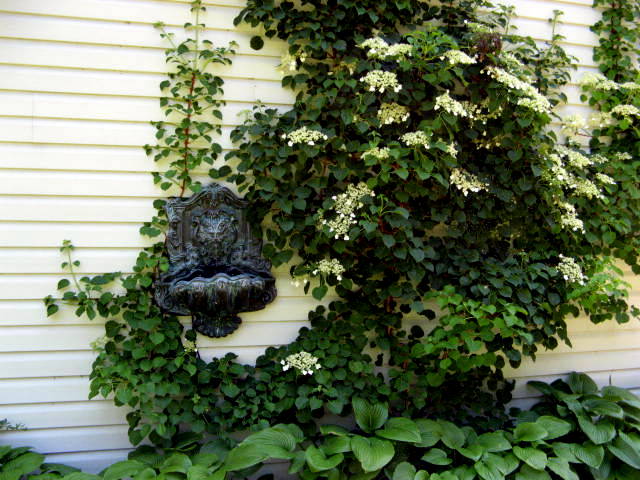
Andrea_44
Hydrangea anomala petiolaris
Other Name
Hydrangea, climbing
Sun Requirements
Full sun, part sun, part shade
Bloom Period and Seasonal Color
Spring to early summer with white flat flowers.
Mature Height x Spread
30 to 50 feet x 5 to 8 feet
Added Benefits
Attracts beneficials
This strong, woody deciduous vine has beautiful, dark green, glossy leaves and large, white, flat flowers in early summer. Unlike many other vines, climbing hydrangea can flower in part shade. Like ivy, it attaches itself using holdfasts or small rootlets to a wall, fence or building and can climb up to 50 feet tall. Climbing hydrangea can be a slow growing vine at first, but once established it will take off and provide many years of beauty. Climbing hydrangea needs a strong structure to climb on or up. It can enliven the corner of a house or a north wall with its vigorous growth. An added attraction is the cinnamon-colored, exfoliating bark that adds interest in winter.
When, Where and How to Plant
Climbing hydrangea is hardy to zone 5 and may need protection in colder parts of our region. Grow climbing hydrangea plants purchased from a local garden center in spring and plant after all danger of frost has passed. You can also plant in summer as long as the plant stays well watered. Plant in a full sun (cooler areas) to partly shaded location on well-drained, rich soil amended with compost. Avoid, hot, dry locations. Climbing hydrangea will flower best with sun, and will flower less in shade. Space plants 5 to 10 feet apart.
Growing Tips
Keep the soil around climbing hydrangea evenly moist with regular waterings and a layer of bark mulch. Fertilize in spring with a layer of compost and a small handful of an organic plant food.
Regional Advice and Care
Like Boston ivy, climbing hydrangea should be planted against a stone, brick or masonry wall or against a wooden wall that is rot-resistant and you won’t have to paint. When grown against vinyl or common wood siding, the holdfasts will leave marks and rot and mold can develop on the siding. If growing on a wooden or metal trellis near a building, place the trellis at least 3 feet from the structure. Prune climbing hydrangea after flowering to keep the growth in bounds. It is not as aggressive a spreader as the ivies. Be patient with the growth. Climbing hydrangea will often take 3 to 5 years to reach the flowering stage. As the old adage says about perennial vines, “first they sleep, then they creep, then they leap”. There are no significant pests of climbing hydrangea, except deer.
Companion Planting and Design
Grow climbing hydrangea along a wall, building or fence where it can become a permanent fixture. It’s perfect for a forgotten north or east wall along a garage or the side of the house. Grow climbing hydrangea up trees, pergolas, and arbors. Just make sure the structures are strong enough to support the weight.
Try These
Most garden centers carry the white flowered, green leaved species. ‘Miranda’ is a new, variegated leaf variety with cream and green colored foliage and white flowers.
Excerpted from my book, New England Getting Started Garden Guide.


